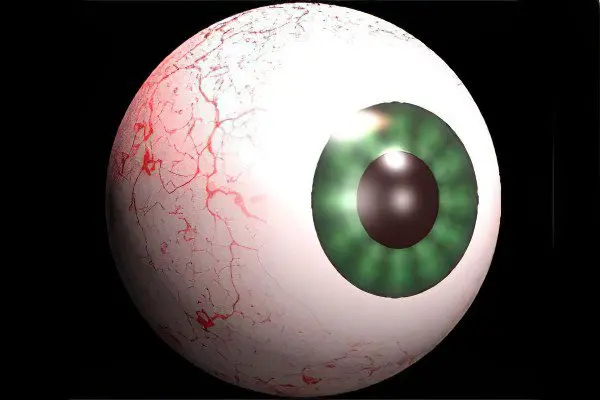Contents
Among malignant neoplasms that can be localized in any organ and system of the human body, eye cancer is much less common than others. This term refers to tumors that develop on the conjunctiva, retina, choroid, orbit, or appendages of this organ (eyelid, lacrimal glands).
Causes of eye cancer
Eye cancer develops due to various adverse factors. To warn some in the power of man, others act regardless of our desire.
The main causes of eye cancer are:

Heredity. In relatives, especially of several generations, this disease is much more common.
Unfavorable environmental conditions are becoming a common cause of oncology, including eye cancer.
HIV-infected people and AIDS patients are at an increased risk of developing these tumors.
Eye cancer may be secondary due to metastasis of another malignant tumor in the human body.
Exposure to ultraviolet rays.
The presence of pigment spots on the shell of the eye (nevi).
Doctors do not exclude the development of a tumor against the background of a general decrease in immunity due to a variety of reasons.
Types of malignant lesions of the eye
Tumors of the eye are classified according to their location:
Malignant neoplasms of the eyelid:
squamous cell carcinoma – usually rapidly progressive, metastases to nearby lymph nodes
basal cell carcinoma (basalioma) – metastasizes extremely rarely, manifests itself in an ulcerative or nodular form
adenocarcinoma – thickening in the thickness of the eyelid
Tumors of the conjunctiva:
papillomatous variety – accompanied by the formation of nodules of different sizes
pterygoid variety – a white dense film is formed with a clear pattern of blood vessels
Cancer of the lacrimal gland and orbit (may develop at any age, even childhood):
rhabdomyosarcoma – formed on the muscles of the eye
adenocystic carcinoma – affects the lacrimal gland, grows slowly, but metastasizes deeply, relapses are frequent
A malignant tumor of the choroid – most often located in the vascular membrane of the eye, located under the sclera. Less commonly in the ciliary body, located just behind the iris. Very rare cases of lesions of the iris (no more than 6%).
Retinal cancer (retinoblastoma) is a rare type that occurs in children under 2 years of age. With a hereditary form, both eyes are affected, in the absence of a connection with chromosomal disorders, it captures one eye.
Symptoms of the disease

The early stages of malignant tumors of the eye are asymptomatic. But as soon as the tumor increases in size, it will make itself felt.
Each type of oncological lesion of the eye has specific signs, but there are also similar manifestations:
drop in visual acuity
the presence of a spot in the field of view
the appearance of a spot on the iris
displacement of the eyeball
strabismus
By itself, none of these symptoms does not indicate the presence of a tumor, but is a sufficient reason to consult a doctor for a detailed examination.
Varieties of tumors can be manifested by such distinctive features:
Tumors of the eyelid can manifest themselves as thickening or outgrowths.
Nodular neoplasms on the conjunctiva or the appearance of a dense whitish film on it, which thickens over time, will quite accurately indicate their oncological nature.
Feeling of a foreign body in the eye, tearing, pain, swelling of the eye are the companions of lacrimal gland cancer, which progresses very quickly.
The symptoms of a tumor of the choroid are very expressive, although sometimes this type of cancer proceeds without obvious manifestations until the last stages, expressed only by a decrease in vision. Due to the tumor, retinal detachment occurs, a person experiences severe pain, and intraocular pressure rises. The eye is limited in mobility.
Signs of retinoblastoma in children can be strabismus and photophobia. In the photographs, the pupil of the affected eye shines with a light tone. Since this tumor can develop in infancy, the child should be consulted with an ophthalmologist in the first years of life, especially if relatives have had cases of such a disease.
Any case of discomfort in the eye area requires a specialist consultation in order to diagnose the disease in time.
Diagnosis of the disease
A preliminary diagnosis can sometimes be made by a doctor when examining a patient, conducting ophthalmoscopy.
To confirm the diagnosis, examinations are carried out that help determine the type of eye cancer:
Ultrasound of the eyeball
echography of the eyes
fluorescein angiography
CT scan
X-ray examination
histological examination
In each case, the doctor will determine the necessary studies to confirm or refute the presence of a malignant tumor, its size and area of damage.
Eye cancer treatment

Modern medicine involves a complex effect on the tumor, not only to destroy it, but also to prevent the recurrence of the disease.
Whenever possible, organ-preserving techniques are used. But it all depends on the stage of development and localization of the tumor. It is not always possible to save the eye; in this case, an artificial eyeball is implanted.
Surgical treatment is widely used, which is sometimes supplemented with chemotherapy or radiation therapy. Recently, brachytherapy has become more widespread, when radiation is directed directly at the tumor, which minimizes the harmful effects on nearby tissues. The patient’s quality of life practically does not suffer, and he can quickly return to his usual way of life.
Sometimes good results are achieved with cryodestruction or short-focus X-ray therapy (for example, with localization on the eyelid, if treatment is started in the early stages).
The prognosis of the disease depends entirely on the stage at which the detected tumor is located. The earlier treatment is started, the higher the percentage of its success (from 84% in the early stages to 47% with large tumors).
Specific prevention of eye cancer can only consist in minimizing risk factors. The most important is regular check-ups with an ophthalmologist (at least once a year). For those who have successfully overcome the disease, such examinations are mandatory.
Like many malignant tumors, oncological lesions of the eye in the early stages do not make themselves felt. But due to the fact that this organ is in plain sight and with its help we receive daily information about the world around us, it is possible to notice changes in its normal functioning early enough to start treatment.










Nvdnii hort hawdariin talaar medlegtei Emneleg emch bnu